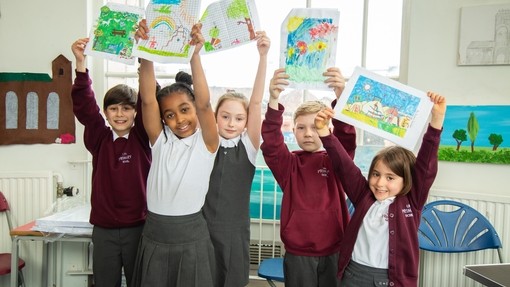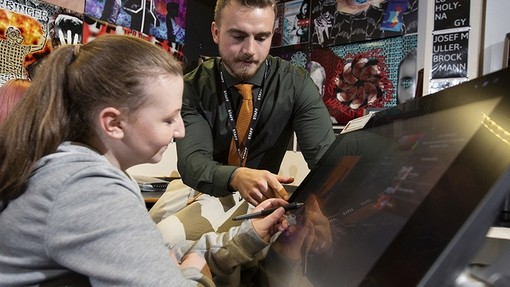Content
Martin Knowles, headteacher of the Essa Academy in Bolton, has long been a proponent of the arts, believing that they are a crucial way to broaden learning experiences and give pupils the chance to succeed in a wide array of subjects. At the end of his first year as headteacher, he made art lessons compulsory.
“We had a lot of students for whom English was their second language – but art is a universal language so I knew it could be a real win for students to succeed in areas such as music, arts, drama,” he said.
“We are already reaping rewards with pupils achieving high grades in arts subjects and that can then act as a ‘hook’ for students to want to succeed in school more generally.”
Spreading the arts in schools
Of course, this is a big commitment and Mr Knowles acknowledges that senior leaders have to be willing to be bold in their approach if looking to do something similar, especially when the arts are not always given the prominence they should have in schools.
“The only way this approach will succeed is if senior leaders and governors have a firm belief in it as a way forward,” says Knowles. “You have to have that commitment and vision because if you don’t, you’re fighting against the tide.”
Thomas Procter-Legg, headteacher at Iffley Academy, a special education school in Oxfod, has also worked to further enhance the school’s arts provision since becoming head just over 12 months ago, as he believes it is a key way to broaden children’s educational experiences.
“Arts have always been a big thing here, but what we have done is used the Artsmark accreditation, [the Arts Council’s creative quality standard for schools], as a specific school improvement vehicle,” he says. The school did this by boosting its collaboration with museums, galleries and libraries in the area to give children more outside learning opportunities.
This was no small change and he says that in order to ensure that it had the support and focus it needed, he involved his governors from the beginning so they understood what he was trying to achieve and would support him in this goal.
Collaboration with school governors
“I knew I needed governor buy-in to work in this way, so I met with the governors and spoke to them about projects I wanted to do, and wrote our Statement of Commitment for our Artsmark application in collaboration with the chair of governors,” he says.
This positive engagement even went as far as getting governors to help with cultural trips, with one governor offering support during a visit to the Anne Frank museum in Amsterdam. “That’s really brilliant buy-in,” he adds, noting how it helps to demonstrate across the school the value that arts and culture is being given.
Indeed, the support governors that provide can be particularly helpful because they can bring in experience, knowledge, expertise and connections that teachers may not otherwise have.
Support networks
Gill Balfour works for arts organisation Z-Arts in Manchester, and is a governor at Webster Primary School. She says that, given her background, the school can tap into her connections and understanding of the arts sector, which can help it to focus its arts provision in the best way possible.
“It’s really important for senior leaders to value the arts and I think this is where having a board of governors that have a range of backgrounds – both in terms of who they are and the jobs they do – to give you a broad outlook on the education the children in the school are receiving is really helpful,” she says.
Ivan Wadeson, a governor at the Essa Academy and chief executive of The Dukes theatre in Lancaster, adds that those with arts sector experience can also help by giving schools advice and insights into how arts and culture initiatives are best put together.
“I know, having worked in the cultural sector for a long time, that we’re culpable of trading in acronyms and jargon, but cutting through that and being able to make quick connections and give advice, […] the more I can support them to make quick and informed decisions, the better,” he says.
Essa Academy decided to use the Artsmark framework for its arts provision because it provided a structure around which to establish its plans and goals. Wadeson was able to support the school when writing its submissions for Artsmark and ensure that it clearly demonstrated how it met the Artsmark criteria. This sort of advice can complement the support that Arts Council’s Bridge organisations offer to Artsmark schools.
There is also a module from the National Governance Association that can help give governors insight into how arts and culture initiatives can be used for school improvement.
Money talks
While senior leaders can get support from governors, teachers also need support from senior staff when they are trying to push arts initiatives. Teacher Lauran Hampshire-Dell says that when putting together a plan for how arts and culture would be implemented in her school, the support from senior leaders was crucial – both at the planning stage and throughout its delivery.
“We created a two-year plan which the SLT really supported: from planning and funding for speakers or artists to come in, to promoting to parents the value of the arts, speaking about it at parents’ meetings and publicly praising students who participated. I think if SLT present it as important across the school, the rest follows,” she says.
This is also true from a financial perspective. Hannah Phelan, EYFS and arts lead at Webster Primary in Manchester, says being able to rely on her headteacher for financial support is key to enabling her to plan arts delivery initiatives with confidence.
“Although students get great provision without funding, it wouldn’t be to the level we want it to be [without funding],” she adds.
Knowles, from the Essa Academy, agrees and says this is often another point that senior leaders must factor into their plans. “When I was advocating to the governors [to develop arts provision], I made it very clear there would be a financial commitment,” he says.
Ultimately, by leading from the top – from starting arts journeys to funding and engaging with trips or supporting staff who want to develop arts ideas – senior leaders and governor support is a cornerstone of delivering arts initiatives successfully.


